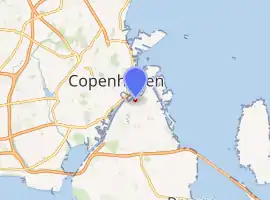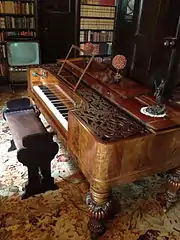Lille Mølle, Christianshavn
Lille Mølle (English: Little Mill) is a historic house museum in the Christianshavn neighbourhood of Copenhagen, Denmark. It was the last windmill on the old ramparts of Christianshavn. It is a Dutch smock mill erected in 1783 on one of the bastions, replacing a post mill built in 1669. It was turned into a private home in 1916.
| Lille Mølle, Christianshavn | |
|---|---|
 | |

| |
| Origin | |
| Mill name | Lille Mølle |
| Mill location | Christianshavn, Denmark |
| Coordinates | 55.671446°N 12.596251°E |
| Year built | 1783 |
| Information | |
| Purpose | Corn mill |
| Type | Smock mill |
| Base storeys | Three-storey base |
| Smock sides | Eight sides |
| Year lost | 1909 |
Until 2016, the Little Mill was open to visitors on limited opening hours. Everything was left exactly as it stood when the house was still lived in. The home was at the same time highly eclectic and typical of its period. The National Museum closed this historic house museum in 2016.[1][2][3]
History
The first windmill
.jpg.webp)
The first windmill on the site was a post mill built in 1669. It was one of numerous windmills which were constructed on Copenhagen's Bastioned Fortifications. The only other of these to survive today is the windmill at the Kastellet fortress. In the event of siege, a fortified city needed secure supplies, including supplies of flour and rolled groats. In the same time, a location on the bastions provided favourable wind conditions.[4]
The second windmill

The olf windmill was replaced by a Dutch smock mill erected in 1783. In 1832 the complex was expanded with a four-story steam mill. Together the two mills acted as a grain mill, supplying the citizens of Copenhagen with flour. At the end of the 19th century the mill cap was disassembled and for a while the mill was used by the military for storing straw needed for some nearby barracks, both as fodder for the horses and bedding for the soldiers whose mattresses needed an occasional refill.[4] In 1909 the steam mill was put out of operation.
Conversion into a home

In 1916, Little Mill was acquired by Ejnar Flach-Bundegaard, a young engineer, who turned it into the private home of himself and his wife as well as a small factory, DIAF - Dansk Instrument og apparatfabrik (English: Danish Instrument and Device Factory). Mr. and Mrs. Flach-Bundegaard made their highly eclectic home in the five storey octagonal mill base. The factory was located in the steam mill and a warehouse that has now been demolished on the other side of Christianshavn Voldgade.
The museum today


Ejnar Flach-Bundegaard died in 1949 and his widow in 1974. Shortly before her death, she donated Little Mill to the Danish National Museum, and today everything stands exactly as it did when the couple were alive.
Despite not being a typical home, Little Mill is in some ways characteristic of its period, being furnished in a national romantic yet uniquely personal style.
References
- The National Museum closes Little Mill, retrieved 2018-05-11.
- House museum Little Mill closes: "They were tourists, before there was anything called tourism", (in Danish) Politiken, 28 November 2016, retrieved 2018-05-11.
- Little Mill closes, (in Danish) Berlingske, 28 November 2016, retrieved 2018-05-11.
- "Løvens Bastion" [The rampart of the Lion] (in Danish). Christianshavns Lokalarkiv -. Retrieved 2009-04-08.
External links
| Wikimedia Commons has media related to Lille Mølle, Christianshavn. |
[[Category:Listed agricultural buildings in Copenhagen}}